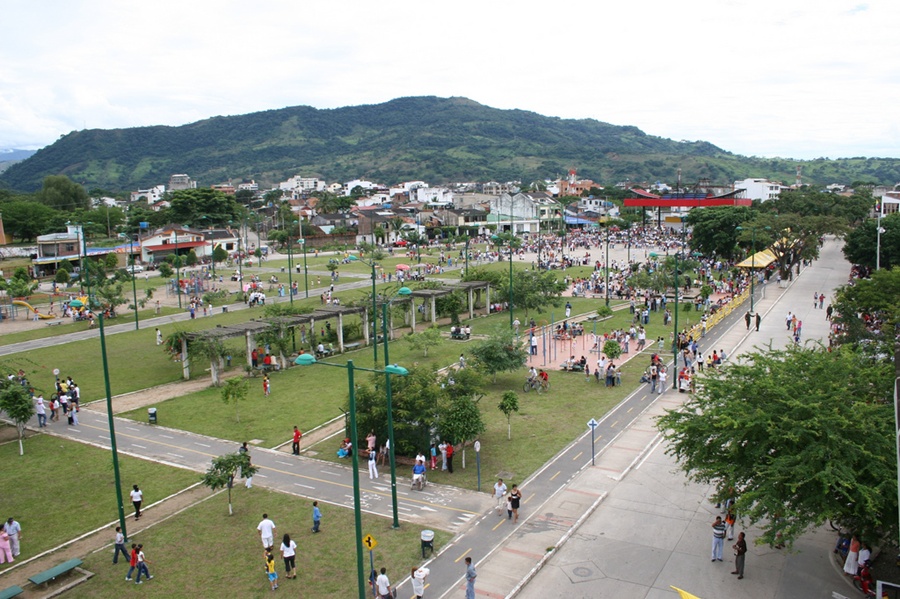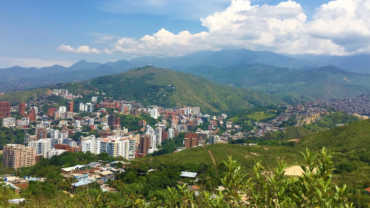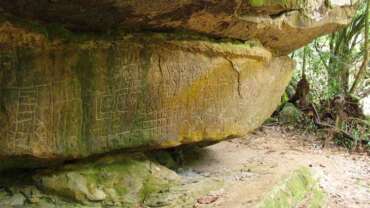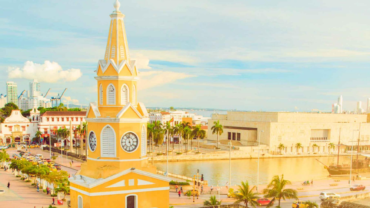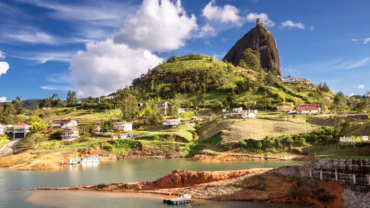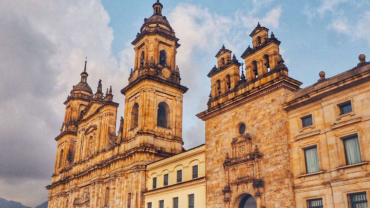Colombian Plains
Explore the natural and cultural wealth of Colombia’s Eastern Plains
These warm grassland plains hold some of the most beautiful places in the country.
Your visit to Colombia wouldn’t be complete without a trip to see the sun set over the plains; a postcard-perfect image of magnificent trees crowning miles of plains that extend further than the eye can see, challenging us to discover what secrets lie far off in the distance.
We can’t tell you about all of the hidden treasures of the Eastern Plains, but we can guarantee that the region’s cultural and natural treasures make their mysteries worth exploring.
In the vast Eastern Plains, whose urban center is found in the growing city of Villavicencio, you’ll find some of the most surprising and emblematic natural marvels of the country. One such marvel is Caño Cristales, a river named for the rainbow of colors that decorate its riverbed thanks to the aquatic plants that grow there.
The area’s abundant flora and fauna, which make it perfect for ecological tourism, are evident in places like the Los Ocarros Bioparque and the Manacacías River, where you can observe a number of fascinating species, including unusual pink dolphins.
The impressive natural wealth of this region is accompanied hand-in-hand by an equally fascinating cultural tradition cultivated by the “llaneros,” workers who raise cattle and are known for wearing “liquiliquis” (an outfit generally comprised of a button-down shirt and matching pants). These herders tell ghost stories, participate in “coleos” (an event in which the “llaneros” pursue cattle on horseback), and dance the “zapateo” to “joropo” music.
There’s no festival that celebrates “llanero” culture better than the International Joropo Tournament. At the tournament, you’ll have the opportunity to sample authentic “llanero” cuisine, which is comprised of capybara, cachama (a type of fish), hallaca (corn dough filled with a stew of meat and other ingredients like raisins, capers, and olives), guarapo (a traditional Colombian cold drink), and, of course, mamona (a traditional dish using barbequed veal).
As if that weren’t enough, the Eastern Plains, which make up no less than 28% of Colombia, also happen to be home to what is jokingly known as the country’s “ombligo,” or bellybutton. The Obelisco de Puerto López, an obelisk that indicates the country’s exact geographic center, can be visited in the department of Meta.
There are over 126,000 square miles of plains ready for you to explore. Don’t miss out on this magnificent adventure—come enjoy the culture, nature, and incomparable views of the Colombian Eastern Plains.
Yopal
Yopal comes from the indigenous word yopo, which means heart and refers to a timber tree. The municipality, capital of the department of Casanare, was founded on February 22, 1915 and has an average temperature of 26 ºC. This land was essential to achieve Freedom, because from these Plains came the troops that helped expel the Spaniards in the 19th century.
The culture of the native of Yopal belongs to the llanera culture which is being radically broken by the pluricultural manifestations, there is a need to make cultural identity compatible with the development of the modern world.
When you know the plain it is undoubtedly we must visit Yopal, beautiful land of plains and landscapes of the other world, it is ideal for adventure tourism, water sports and the parra nda.
Yopal has several sites of interest to the visitor, such as: shopping centers, museums, night rumba sites, parks, among the most prominent sites in the city.
In Yopal it has several sites of interest for visitors such as shopping centers, museums, night rumba sites, parks, among other highlights of the city.
Visit San Agustin and discover the greatest mysteries of pre-Columbian civilizations.
Read More
What to do in Yopal
From the viewpoint of Bellavista, in the west of Yopal, the plain seems dawn without limits while the sun stains the sky of red, pink and orange tones. This is a good place to appreciate the landscapes of this city, where travelers enjoy with the joropo, a rhythm of the Plains; and they enjoy typical dishes like la mamona (beef), among other things in Yopal.
Visit the skyscraper the emblem of the city of Yopal and is adorned by a beautiful road that makes the ride more enjoyable.
Enjoy our parties such as International Tournament with a strong voice, Yopal Festival, National Colonies Festival, Garcero del Llano Festival and many more events you will find in Yopal.
Yopal has a large number of medium and small hotels, the hotels built during the oil boom and the hotels made for tourism in the municipality.
Unique experiences
In Yopal not only sunrises and sunsets are seen that amaze. You can also dance joropo and even practice adventure sports such as rafting.
Try the typical Yopal food such as RICE BREAD, ENTREVERADO, RICE AREPES among others.
Activities you can’t miss
Contemplating the landscapes of the Llano, dancing joropo and practicing adventure sports such as ‘rafting’ are plans that attract travelers who get to know Yopal and the department of Casanare.
Villavicencio
Villavicencio, home of the llanero tradition
In Villavicencio, capital of the department of Meta, the mountains of the Cordillera Oriental give way to Colombia’s expansive Eastern Plains. This stunning, picture-perfect scene is made even more beautiful as the day draws to a close, the sun sinking over the horizon in a perfect “llanero” sunset.
“Villavo,” as the city is affectionately called, is characterized by llanero folklore and traditions like coleo (an event where small groups of llaneros, Colombian cowboys or herders, pursue cattle on horseback) and joropo music, which uses instruments like harps and maracas to get everyone on their feet and dancing the zapateo.
Don’t miss your chance to sample some famous llanero dishes like mamona (a dish based around veal, which is generally either barbequed or cooked over a fire), gallina criolla (a chicken dish), sancocho de gallina (a type of chicken soup), pan de arroz (rice bread), tungos (different types of filling wrapped in a corn or rice dough), beef or fish pisillo (a dish usually composed of salted meat and hogao, a savory blend of onions, garlic, tomatoes, and other ingredients), cachama (a type of fish), mojarra (bream), hayacas (meat filling wrapped in corn dough and steamed or cooked), and cachapas de maíz tierno (a type of pancake made with corn).
Read More
What is there to do in Villavicencio?
Villavicencio has many different places of interest to tourists that you can enjoy during your stay, like the Parque los Fundadores. This beautiful park, which covers nearly 15 acres of land, is the largest in the city.
In the park’s plaza you’ll find a majestic monument dedicated to the Founders, created by famed artist Rodrigo Arenas Betancourt. The park also has a plaza with local food vendors and foot paths where you can take a stroll or play sports.
There’s also the Parque La Llanura, previously known as Parque Sikuani, which has areas for playing tennis, squash, basketball, and football.
In the city, you’ll also be able to visit the Our Lady of Mount Carmel Cathedral, a temple consecrated to the Virgin Mary. This beautiful structure is a popular destination for both tourists and pilgrims.
The Casa de la Cultura Jorge Eliecer Gaitán is another interesting place you can visit. Founded in 1971, it houses a museum dedicated to displaying different cultural pieces from around the city.
During your stay in Villavicencio, you should also make time to visit the Germán Arciniegas Municipal Library. This National Monument is a complex of over 45,200 square feet that includes a main hall for celebrating important events.
In the outskirts of Villavicencio, you’ll find the Mirador Piedra del Amor, an observation site heavily frequented by tourists and hikers who come to enjoy a change of pace. The site offers a peaceful, natural setting and panoramic view of the bustling city below.
Unique experiences
To make your trip to Villavicencio truly memorable, dive into llanero folklore and culture. You can start by attending the International Joropo Tournament, which is held between June and July.
The International Joropo Tournament is an annual event that attracts approximately 500,000 national and international spectators.
Throughout the event’s nearly 50 years of history, it has solidly secured its reputation as the best way to truly experience the llanero way of life.
The International Coleo Convention, which is held each October of each year, also takes place in Villavicencio. Coleo requires great expertise and skill working with livestock and consists of riders on horseback pursuing steers and pulling them, often by their tails, in an effort to tip them over. The convention and the accompanying traditional activities such as joropo music and dancing bring in over 200,000 visitors each year, making this event one of the most significant “cowboy”-style event in the Americas.
Activities you won’t want to miss out on
One of the biggest tourist attractions in Villavicencio is cycle tourism. For that reason, there are many bike paths you can use to explore both the urban and natural areas of Meta’s capital.
To fully appreciate the area’s abundant wildlife, we recommend that you visit the Bioparque Los Ocarros, a zoological park located about 2 miles from Villacencio on the way to Restrepo. The park consists of about 13.5 acres and was named for a type of giant armadillo native to South America.
Los Ocarros is home to about 1,200 animals from 193 different species and displays all of the rich, natural beauty of the Eastern Plains.
You can also participate in cultural tourism in the Parque Las Malocas, which has a fascinating trail you can follow to learn more about the myths and legends of the Plains, like the stories of el Patasola, el Silbón, Florentino and the Devil, la Llorona, Juan Machete, la Bola de Fuego, el Ánima de Santa Helena, and la Madremonte.
And, if you’re interested in learning more about the area’s indigenous communities, you can visit Maloca Maguaré, where the HUITOTOS themselves relate the most relevant aspects of their culture.
Recommendations
Villavicencio has a warm climate, with an average temperature that ranges from about 68 to 109°F. You should bring light clothing; however, the primary source of Villavicencio’s beautiful plant life is its abundant rainfall, so don’t be surprised if you experience some heavy showers.
It’s easiest to reach the city by land, but it can also be reached by air. There are some Airlines that offer flights to Villavicencio, including ADA, Avianca, Easyfly, and Satena.
Villavicencio also has a wide range of accommodations available within and in close proximity to the city, including hotels, ranches, hostels, hosting services, resorts, and camping areas.
If you plan to travel from Villavicencio to more remote areas, we strongly recommend that you verify whether you need to be vaccinated against yellow fever.
With these recommendations, you’re ready to enjoy Villavicencio and its fascinating llanero heritage. Come explore this marvelous destination in the Colombian plains!



